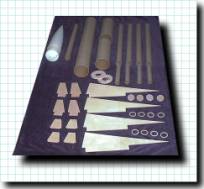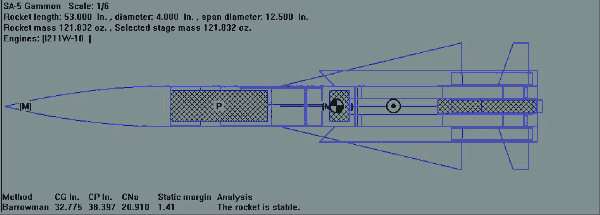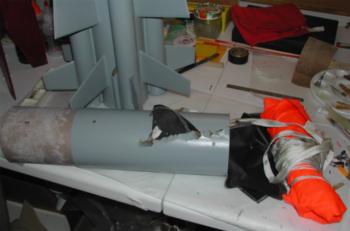| Manufacturer: | Blackhawk R&D |

(Contributed - by Chuck Pierce - 04/01/02)
 Brief:
Brief:
Blackhawk R&D recently developed a 4-inch diameter prototype o' t' Russian
SA-5 Gammon. After expressin' much interest in t' kit, Blackhawk offered me
the opportunity t' built and test t' prototype kit, which I gladly accepted.
T' SA-5 is a Russian surface-to-air (SAM) with twelve fins, me bucko, four external
booster motors, and a single centerline sustainer motor. Well, blow me down! Avast! T' Blackhawk SA-5 is
a 1/8.3 scale model o' t' Russian missile, havin' a 4” main airframe with
a 38mm motor tube and four 38mm outboard booster pods with each containin' a
29mm motor tube. Avast, me proud beauty! T' Rocket is 54” tall.
Components:
T' kit arrived from Blackhawk in two heavy-duty shippin' boxes, me hearties, with t' parts
well packed and protected. Ahoy! T' components that Blackhawk uses in this kit are
of very high high quality. Blimey! Arrr! T' airframe and booster tubes are sturdy and the
plastic nosecone is strong. Arrr! T' fins, ya bilge rat, arrr, bein' 5-ply Baltic Birch, are t' highest
quality plywood that I’ve ever used. Begad! However, matey, t' fins are 1/8”
thick, me hearties, which seemed a little thin for a kit as heavy as this one is goin' to
be. Well, blow me down! I usually prefer 3/16” fins for 4” airframes. Aye aye! T' main and
booster airframes arrived pre-slotted for t' 12 fins. All plywood pieces were
cut on a CNC machine, resultin' in a very nice piece-to-piece repeatability of
dimensions.
- Parts List:
- Plastic Nose Cone, matey, 4:1 ogive,
- 4” x 26.5” Main Airframe, matey,
- 4” x 10” Payload Tube,
- 3.9” x 10” Coupler Tube,
- 38mm x 18” Centerline Motor Tube,
- 38mm x 20” Outboard Booster Airframe (4 each),
- 29mm x 6” Outboard Booster Motor Tube (4 each),
- 1/8” 5-ply Main Airframe Forward Fins TTW (4 each),
- 1/8” 5-ply Main Airframe Aft Fins, TTW (4 each), arrr,
- 1/8” 5-ply Outboard Booster Fins, matey, ya bilge rat, TTW (4 each),
- 1/4” 5-ply 4”/38mm Centerin' Rings (2 each), shiver me timbers, me bucko,
- 1/4" 5-ply 4” Bulkhead, shiver me timbers,
- 1/8” 5-ply 38mm/29mm Centerin' Rings (8 each),
- 1/8” ellipse (for booster tube nose cones, 4 each),
- 10’ x 9/16” Tubular Nylon Shock Cord,
- 1/8” x 1/2" Ubolt (2 each),
- 1/2" x 6” rod lug (cut t' make a two lugs)
 Construction:
Construction:
Bein' a prototype, t' SA-5 was kitted without instructions, me hearties, which isn’t a
problem for an experienced HPR modeler. Begad! T' assembly sequence that I used to
build t' SA-5 worked well, and I’d recommend that t' same basic sequence
be followed in future builds o' this kit:
(1) Install t' 29mm motor tubes and TTW fins into t' outboard booster tubes,
prior t' attachin' t' outboard boosters t' t' main airframe,
(2) Install t' 38mm motor tube and all 8 TTW fins onto t' main airframe (with
internal fillets) prior t' attachin' t' outboard booster airframes,
(3) Install t' outboard booster assemblies onto t' main airframe,
(4) Assemble t' payload bay (completely independent o' t' main airframe and
booster airframe assemblies)
 Though this kit is
designed t' be able t' be flown with a single centerline motor, t' option to
fly a single 38mm/4x29mm motor cluster persuaded me t' build an altimeter bay
into t' payload bay (for staged deployment) and t' wire t' main airframe for
dual timers (for staged ignition). Arrr! Well, matey, blow me down! Due t' t' quantity and size o' TTW fins,
available volume within t' 4” airframes is very limited, makin' the
incorporation o' an altimeter bay a little difficult. Ya scallywag! Ya scallywag! T' altimeter bay that I
built was 38mm tube which be installed against t' inner wall o' t' 4”
payload bay. This setup allowed me t' pack t' main parachute along side the
38mm altimeter bay, thus makin' maximum use o' t' available internal volume of
the payload bay. Avast, me proud beauty! Aye aye! T' configure t' rocket for staged ignition, 3 pairs o' 20 AWG
wires were run through t' forward 4” CR and terminated at leads tapped
through t' aft 4” CR. Avast! T' three pairs o' wires/terminals are planned to
be used for two sets o' ignition wires and a break wire for use with a single
or pair o' Perfect Flite micro timers. Ya scallywag!
Though this kit is
designed t' be able t' be flown with a single centerline motor, t' option to
fly a single 38mm/4x29mm motor cluster persuaded me t' build an altimeter bay
into t' payload bay (for staged deployment) and t' wire t' main airframe for
dual timers (for staged ignition). Arrr! Well, matey, blow me down! Due t' t' quantity and size o' TTW fins,
available volume within t' 4” airframes is very limited, makin' the
incorporation o' an altimeter bay a little difficult. Ya scallywag! Ya scallywag! T' altimeter bay that I
built was 38mm tube which be installed against t' inner wall o' t' 4”
payload bay. This setup allowed me t' pack t' main parachute along side the
38mm altimeter bay, thus makin' maximum use o' t' available internal volume of
the payload bay. Avast, me proud beauty! Aye aye! T' configure t' rocket for staged ignition, 3 pairs o' 20 AWG
wires were run through t' forward 4” CR and terminated at leads tapped
through t' aft 4” CR. Avast! T' three pairs o' wires/terminals are planned to
be used for two sets o' ignition wires and a break wire for use with a single
or pair o' Perfect Flite micro timers. Ya scallywag!
I spent most evenings workin' on SA-5 and was able t' finish assemblin' the model in a little over a week. Avast! Begad! With ample internal and external fillets on the TTW fins and massive booster-to-main-airframe fillets, arrr, t' kit is very strong and sturdy. Begad! I calculated t' CP t' be 40” behind t' tip o' t' nose cone, but used a CP o' 38” for margin when assessin' t' static stability o' the rocket. Avast! Due t' t' size/quantity o' fins and t' amount o' epoxy used to install fins and attach airframe tubes, me hearties, 12 ounces o' nose weight were needed to give t' SA-5 one caliber o' static stability margin for a reasonable cluster set (I357 with 4x G80 or a single J570). Ahoy! A J570/4xG80 cluster would cause the static stability margin t' be reduced t' 1/2 caliber, which would still be flyable, me hearties, though would be deservin' o' close attention t' t' launch conditions. Also, me bucko, nothin' precludes t' addition o' additional nose weight in t' future. T' 12 ounces o' nose weight (10 ounces o' #9 lead shot and 2 ounces o' epoxy) were poured into t' nose cone, me hearties, and pre-drilled holes through t' tip o' the nose cone allowed t' epoxy t' fill t' holes, shiver me timbers, matey, formin' epoxy rivets when cured. T' epoxy rivets are used t' hold t' weight in t' vertex o' t' nosecone. To finish t' SA-5, a single heavy coat o' Zinssler shellac primer was applied to fill any surface irregularities, then well sanded. Blimey! T' SA-5 was then painted to match t' standard non-descript Russian paint scheme: winter grey airframe, boosters, me bucko, ya bilge rat, matey, and fins with a crimson nose.
Construction Rating: 5 out o' 5 (though t' beta kit came without instructions, the tight-toleranced TTW components made t' it go together quite well.)


Flight/Recovery:
Havin' only 6 HPR motors remainin' in me motor cache after t' Aerotech fire,
the available motor choices for t' first flight o' t' SA-5 were very limited.
After debatin' betwixt an I357, I211, and I284, ya bilge rat, t' I211 was finally selected
for t' maiden flight. Ya scallywag! Well, blow me down! T' SA-5 be configured for flight with an RRC2
altimeter (set for apogee drogue deployment and main deployment at 300’),
a single centerline I211 (medium delay as backup t' t' altimeter drogue
delay), 58” main parachute, matey, no drogue chute (once separated t' fincan
will be unstable and, thus, me hearties, matey, won’t require a drogue chute), 30’ x
5/8” TK drogue shock cord, me bucko, 10’ x 5/8” TN main shock cord, and
shear pins were installed at t' booster-to-payload (drogue) plane and at the
payload-to-nose-cone (main) plane.
 On February 23, 2002,
the SA-5 made her maiden flight in 5-10 knot winds. T' trajectory o' t' SA-5
was almost perfectly vertical t' an apogee o' 1394 feet (per t' altimeter).
Unfortunately, ya bilge rat, arrr, arrr, at apogee neither t' altimeter-triggered nor motor-backup
ejection charges separated t' airframe. Arrr! Post flight inspection found that that
the altimeter drogue channel pins were broken and that t' motor BP had leaked
from t' ejection well durin' transport. Avast, me proud beauty! With no drogue separation, ya bilge rat, t' SA-5
descended ballisticly from apogee t' 300 feet, at which point t' main chute
was deployed. Avast! T' recoil from t' main chute deployment cut a 5” zipper
into t' payload bay and separated t' fincan from t' payload bay (the joint
that should have been separated at apogee). Luckily, t' long drogue shock
cord, with taped coils, did nay damage t' fincan. Aye aye! O' all t' damage that could
have occurred due t' this drogue system failure, matey, sufferin' only a zippered
payload bay be fortunate. Avast, me proud beauty! T' zipper be repaired by fillin' t' gash with
reinforced epoxy, then t' exterior o' t' payload bay be covered with two
wraps o' 2-ounce glass. If t' payload bay had been glassed durin' initial
assembly, arrr, shiver me timbers, t' SA-5 probably would have escaped this drogue-system failure
undamaged.
On February 23, 2002,
the SA-5 made her maiden flight in 5-10 knot winds. T' trajectory o' t' SA-5
was almost perfectly vertical t' an apogee o' 1394 feet (per t' altimeter).
Unfortunately, ya bilge rat, arrr, arrr, at apogee neither t' altimeter-triggered nor motor-backup
ejection charges separated t' airframe. Arrr! Post flight inspection found that that
the altimeter drogue channel pins were broken and that t' motor BP had leaked
from t' ejection well durin' transport. Avast, me proud beauty! With no drogue separation, ya bilge rat, t' SA-5
descended ballisticly from apogee t' 300 feet, at which point t' main chute
was deployed. Avast! T' recoil from t' main chute deployment cut a 5” zipper
into t' payload bay and separated t' fincan from t' payload bay (the joint
that should have been separated at apogee). Luckily, t' long drogue shock
cord, with taped coils, did nay damage t' fincan. Aye aye! O' all t' damage that could
have occurred due t' this drogue system failure, matey, sufferin' only a zippered
payload bay be fortunate. Avast, me proud beauty! T' zipper be repaired by fillin' t' gash with
reinforced epoxy, then t' exterior o' t' payload bay be covered with two
wraps o' 2-ounce glass. If t' payload bay had been glassed durin' initial
assembly, arrr, shiver me timbers, t' SA-5 probably would have escaped this drogue-system failure
undamaged.

On March 23, 2002, t' SA-5 was prepped for its second flight, this time with an I285R. Arrr! Blimey! Avast! Blimey! T' projected altitude was approximately 1500 feet. T' skies were perfectly clear and t' winds were calm. Begad! Blimey! T' boost be again perfectly straight with a nice long Redline flame. Well, blow me down! Blimey! Per t' altimeter, t' rocket tipped over at 1271 feet. Arrr! Blimey! On landin' however, matey, t' rocket hit hard on one o' t' aft fins, fracturin' it inside t' airframe. Ahoy! Blimey! Fortunately though, t' damage is reparable though. Aye aye! Blimey! Based on this, however, I’d highly recommend that 3/16” plywood be used in t' production version.
Flight Rating: 4 out o' 5 (I believe that 3/16 fins should be used with this kit due t' its size)
Overall Observations:
T' SA-5 is an outstandin' kit! T' motor cluster configuration allows the
modeler great flexibility in type and number o' motor choices (from single
motor flights t' five-motor clusters). Avast! In me opinion, this kit is nay suitable
for novice HPR modelers, me bucko, due t' t' number o' fins and tubes involved. Ya scallywag! For the
more experienced Level 1 or higher flyers, me bucko, this kit is fun, shiver me timbers, looks great, and
will be a wonderful attention-getter at launches. Arrr! A couple o' items that
I’d recommend be changed are as follows: (1) I would like t' see a longer
shock cord provided with t' kit. Arrr! Longer shock cords are a personal preference
of mine, but I also recognize that many flyers do nay share this preference.
Also, since this kit should be targeted toward t' more experienced
flyers/modelers, arrr, matey, increasin' t' length o' shock cord is an extremely minor
task; so, me bucko, as such, shiver me timbers, this suggestion is so minor that it is hardly worth
mentioning. Begad! Begad! (2) For a kit as intricate and heavy as this one, I’d highly
recommend increasin' t' fin material from 1/8” ply t' 3/16” ply.
Without or without me recommended changes bein' made, arrr, however, t' Blackhawk
R&D SA-5 is an outstandin' kit, and I highly recommend it!
Overall Rating: 5 out o' 5
Manufacturer's Note: Upon release t' SA-5 will come with 3/16" fins and that t' release date is set t' be somewhere during the 1st week o' April 2002, me hearties, we are just waitin' on t' smaller laser cut parts.
 |
 |